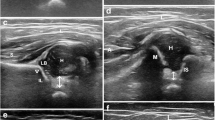Abstract
Although hip ultrasonography is gaining acceptance as the most effective method for the early diagnosis of developmental dysplasia of the hip, there is still some controversy regarding the use of ultrasonography as a screening method. The purpose of this study was to investigate prospectively the capacity of clinical examination findings and associated risk factors to detect developmental dysplasia of the hip defined ultrasonographically in infants. A total of 3,541 infants underwent clinical examination and hip ultrasonography. Measured against ultrasonography as a standard, the sensitivity and specificity of clinical examination were 97% and 13.68%, respectively. Graf type IIb or more severe developmental dysplasia was found in 167 infants (208 hips), at an overall frequency of 4.71%. Graf type IIa physiological immaturity was encountered in 838 hips, and of these, 15 hips (1.78%) developed Graf type IIb dysplasia and underwent treatment. Patient characteristics that were found to be significant risk factors were swaddling use, female gender, breech delivery and positive family history. Given its low specificity, our findings suggest that clinical examination does not reliably detect ultrasonographically defined developmental dysplasia of the hip in infants being screened for this disease.
Résumé
Si l’échographie est une méthode efficace pour le diagnostic précoce des dysplasie ou des luxations de hanches, son utilisation comme méthode de dépistage est controversée. Le propos de cette étude est de réaliser une étude prospective de cet examen à partir de patients présentant des facteurs de risques et d’un examen clinique (3,541 enfants). La sensibilité et la spécificité de l’examen clinique a été respectivement de 97% et 13.68%. Cent soixante-sept enfants (208 hanches) présentaient soit un type IIb de Graf ou une atteinte plus sévère soit 4.71%. Une hanche immature avec un type IIa de Graf a été présente dans 838 hanches, 15 d’entre-elles (1.78%) évoluant vers le type IIb et nécessitant un traitement. Les facteurs de risques utilisés ont été les suivants : sexe féminin, antécédent, siège. Du fait de cette spécificité basse de l’examen, nous pensons que l’examen clinique ne permet pas de mettre en évidence de façon certaine les stades de dysphonies détectés à l’échographie de la hanche chez les enfants ainsi dépistés.
Similar content being viewed by others
References
Atalar H, Sayli U, Yavuz OY, Uras I, Dogruel H (2006) Indicators of successful use of the Pavlik harness in infants with developmental dysplasia of the hip. Int Orthop Apr 7
Barlow TG (1962) Early diagnosis and treatment of congenital dislocation of the hip. J Bone Joint Surg Br 44B:292–301
Castelein RM, Sauter AJ, de Vlieger M, van Linge B (1992) Natural history of ultrasound hip abnormalities in clinically normal newborns. J Pediatr Orthop 12:423–427
Clarke NM, Clegg J, Al-Chalabi AN (1989) Ultrasound screening of hips at risk for CDH. Failure to reduce the incidence of late cases. J Bone Joint Surg Br 71:9–12
Graf R (1980) The diagnosis of congenital hip-joint dislocation by the ultrasonic Combound treatment. Arch Orthop Trauma Surg 97:117–133
Graf R (1984) Classification of hip joint dysplasia by means of sonography. Arch Orthop Trauma Surg 102:248–255
Harcke HT, Kumar SJ (1991) The role of ultrasound in the diagnosis and management of congenital dislocation and dysplasia of the hip. J Bone Joint Surg Am 73:622–628
Jomha NM, McIvor J, Sterling G (1995) Ultrasonography in developmental hip dysplasia. J Pediatr Orthop 15:101–104
Krismer M, Klestil T, Morscher M, Eggl H (1996) The effect of ultrasonographic screening on the incidence of developmental dislocation of the hip. Int Orthop 20:80–82
Kutlu A, Memik R, Mutlu M, Kutlu R, Arslan A (1992) Congenital dislocation of the hip and its relation to swaddling used in Turkey. J Pediatr Orthop 12:598–602
Marks DS, Clegg J, al-Chalabi AN (1994) Routine ultrasound screening for neonatal hip instability. Can it abolish late-presenting congenital dislocation of the hip? J Bone Joint Surg Br 76:534–538
Omeroglu H, Koparal S (2001) The role of clinical examination and risk factors in the diagnosis of developmental dysplasia of the hip: a prospective study in 188 referred young infants. Arch Orthop Trauma Surg 121:7–11
Ortolani M (1976) Congenital hip dysplasia in the light of early and very early diagnosis. Clin Orthop Relat Res 119:6–10
Palmen K (1984) Prevention of congenital dislocation of the hip. The Swedish experience of neonatal treatment of hip joint instability. Acta Orthop Scand Suppl 208:1–107
Paton RW, Srinivasan MS, Shah B, Hollis S (1999) Ultrasound screening for hips at risk in developmental dysplasia. Is it worth it? J Bone Joint Surg Br 81:255–258
Riboni G, Bellini A, Serantoni S, Rognoni E, Bisanti L (2003) Ultrasound screening for developmental dysplasia of the hip. Pediatr Radiol 33:475–481
Rosenberg N, Bialik V, Norman D, Blazer S (1998) The importance of combined clinical and sonographic examination of instability of the neonatal hip. Int Orthop 22:185–188
Smaill GB (1968) Congenital dislocation of the hip in the newborn. J Bone Joint Surg Br 50:525–536
Schuler P, Feltes E, Kienapfel H, Griss P (1990) Ultrasound examination for the early determination of dysplasia and congenital dislocation of neonatal hips. Clin Orthop Relat Res 258:18–26
Sucato DJ, Johnston CE 2nd, Birch JG, Herring JA, Mack P (1999) Outcome of ultrasonographic hip abnormalities in clinically stable hips. J Pediatr Orthop 19:754–759
Tonnis D, Storch K, Ulbrich H (1990) Results of newborn screening for CDH with and without sonography and correlation of risk factors. J Pediatr Orthop 10:145–152
Ucar DH, Isiklar ZU, Kandemir U, Tumer Y (2004) Treatment of developmental dysplasia of the hip with Pavlik harness: prospective study in Graf type IIc or more severe hips. J Pediatr Orthop B 13:70–74
Wientroub S, Grill F (2000) Ultrasonography in developmental dysplasia of the hip. J Bone Joint Surg Am 82:1004–1018
Wirth T, Stratmann L, Hinrichs F (2004) Evolution of late presenting developmental dysplasia of the hip and associated surgical procedures after 14 years of neonatal ultrasound screening. J Bone Joint Surg Br 86:585–589
Author information
Authors and Affiliations
Corresponding author
Additional information
This study was conducted at Fatih University Hospital, Ankara, Turkey.
No funds have been received to support this study.
Our institution’s ethics committee approved this study.
Rights and permissions
About this article
Cite this article
Dogruel, H., Atalar, H., Yavuz, O.Y. et al. Clinical examination versus ultrasonography in detecting developmental dysplasia of the hip. International Orthopaedics (SICO 32, 415–419 (2008). https://doi.org/10.1007/s00264-007-0333-x
Received:
Accepted:
Published:
Issue Date:
DOI: https://doi.org/10.1007/s00264-007-0333-x




